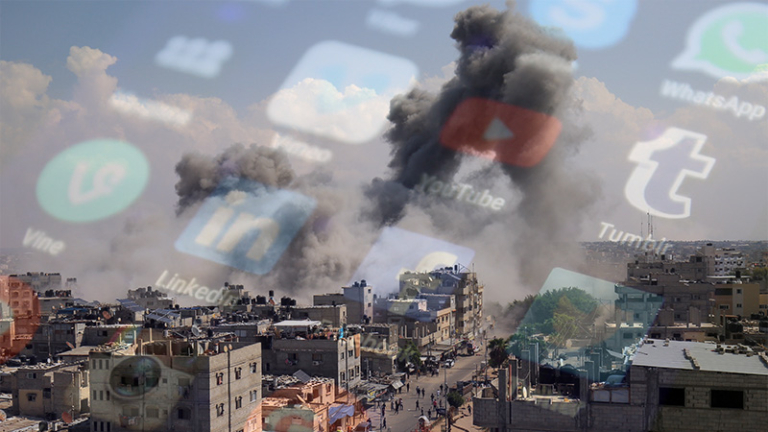
During major events like violent conflict, there is a vacuum of verified and accurate information, as well as high interest and emotions. As the fog of war and polarization make it difficult to verify information and find credible or reliable sources, social media platforms become vital information spaces. But those platforms also become part of the information warfare where disinformation and fake content are rampant, hate speech and incitement spread, and extreme and graphic content gets amplified by the algorithms of social media platforms and garner the most engagement and attention. Social media users share unverified, misleading, or miscaptioned content, spread doctored images and altered documents, and amplify baseless claims. In the coverage of the recent Hamas attack on Israel and the latter’s criminal bombardment of Gaza, the amount of disinformation, false content, and violent hate speech on social media platforms has reached unprecedented levels. This type of content incites further violence, manufactures support for war crimes, and impacts real world policy decisions. The world is witnessing a new phase of the Israeli-Palestinian conflict, and social media content is fanning the flames of further violence.
Unprecedented Scale and Speed of Disinformation
There is a flood of misinformation and falsehoods circulating on social media, claiming to show the recent events in Israel and Palestine, including mischaracterized content, misleading captions, false images, out-of-context and old videos, and video game footage. The level of disinformation, especially on X (formerly Twitter), has never been seen before and is spreading at accelerated speed due to its graphic and emotional nature, which in turn widens its reach. According to some analysts, 20 percent of the accounts participating in these conversations online are fake and mostly operating on X and TikTok. Additionally, there have been tens of millions of posts about the events in Israel and Palestine, and the enormous amounts of unverifiable content, and the speed at which it is spreading, far outpace content moderation measures by social media platforms, especially after waves of layoffs at many tech companies like X and Meta, which impacted content and safety teams.
While disinformation spreads on all social media sites, X is the most impactful as it has been the primary platform for political content, where users go first to find information on breaking news and developing events. However, after being acquired by Elon Musk, X has become the platform with the largest amount of disinformation and hate speech. Musk, who reposts far-right antisemitic accounts and verifiably false content, has eliminated teams that deal with disinformation and human rights and safety at the company, and instituted platform changes that made it easier for false information to spread. For example, the introduction of the $8 per month premium subscription in exchange for the “verified” account with the blue checkmark label boosts the subscribers’ posts to the top of the feed and makes it difficult for users to distinguish between fake accounts and vetted accounts. Some accounts with blue checkmarks have been found to impersonate news outlets and masquerade as journalists disseminating false information and fake reports. The eligibility of verified accounts to monetize their content along with the profit-driven algorithm further increases the spread of false and hateful content as posters are incentivized by sharing content that is more likely to generate view counts.
Moreover, X now relies heavily on user-driven content moderation and fact-checking through the Community Notes feature, but notes are often added only after false content has been viewed by hundreds of thousands if not millions of users, while the false or hateful content remains on the platform and continues to be viewed. The removal of headlines on external links, reportedly for aesthetic reasons, could be further exacerbating the problem as articles are only represented by images without context. Musk’s efforts since taking over Twitter (now X) have essentially removed any existing guardrails on disinformation and hate speech, made it more difficult for researchers to study content and patterns on the platform, and made this information environment more susceptible to exploitation by malicious actors.
The type of false content that goes viral on social media platforms tends to be graphic and extreme, and is intended to inflate one side’s own power or exaggerate the other side’s crimes. For example, images showing children in cages claiming they were Israeli children abducted by Hamas were proven to be false. So were a doctored false Press Release attributed to the White House, an account posing as the Jerusalem Post claiming Israeli prime minister was taken to hospital, a video claiming to show a Hamas fighter with an Israeli girl that was actually posted on TikTok months earlier, and images claiming to show Israeli generals captured by Hamas were actually from Azerbaijan. There also was a video of a beheading of a child claiming Hamas committed the crime, which was actually from 2016 in Syria.
While some organizations have been conducting factchecking of social media content (for example through reverse image searches), they are not able to keep up and the risk of artificial intelligence (AI)-generated content that looks realistic is a real possibility. Additionally, most of the (presumed) primary footage was first shared privately on message apps like Telegram and WhatsApp and then posted on social media platforms. In these cases, is it difficult to fact-check or verify the authenticity, credibility, and source of the content, and whether it gets spun on social media to push a certain narrative. What becomes even more challenging to vet online are secondhand posts that refer to unverified content. For example, the story about 40 babies found beheaded has not been confirmed or verified by any official account and yet continues to circulate on social media (with at least 44 million impressions and 100 thousand reposts) and is reported by mainstream media outlets. The claim was even referenced by US President Biden in his support for Israel’s indiscriminate bombardment of the besieged Gaza Strip, where more than 2 million Palestinians live, 45 percent of whom are children. The gruesome nature of this story contributes to incitement and the justification of war crimes that Israel is committing against civilians in Gaza.
Hate Speech and the Silencing of Palestinian Narratives
In addition to disinformation, hateful and violent content and cyber harassment have been rampant on social media platforms. Some organizations have identified thousands of cases of hate speech including antisemitism, islamophobia, and anti-Palestinian racism, especially on X. There are concerns about the rise in antisemitic content online spreading conspiracy theories and justifying violence against Jewish people around the world, while calls to kill all Palestinians and flatten Gaza as well as other dehumanizing and genocidal language roam freely on social media (sanctioned by statement from prominent political figures such as Nikky Haley, Lindsey Graham, and Marco Rubio, among others).
For Palestinians the threat is two-fold. First, anti-Palestinian racism has become normalized in the American and western psyche that they are rarely treated as equal human beings by the media or politicians, and that is reflected on social media and their content moderation norms, leading to an alarming proliferation of this dangerous rhetoric, with no efforts to address it. Second, the conflation between antisemitism and legitimate criticism of Israeli crimes against Palestinian civilians (heightened by the adoption of the International Holocaust Remembrance Alliance (IHRA) definition of antisemitism by many states and organization), leads to the silencing of Palestinian voices. There are already reports of the removal and shadow banning of Palestinian speech on social media platforms, while at the same time blatantly anti-Palestinian and genocidal language is permitted and widespread. Hate speech and incitement against Palestinians in the Hebrew social media sphere is even more blatant and prevalent, with hardly any restrictions by social media companies.
This trend is particularly concerning because marginalized and oppressed populations like the Palestinians rely on social media platforms to share their grievances and document human rights abuses against them. This is important, especially when mainstream media outlets continue to present biased accounts, exclude Palestinian voices and stories, and perpetuate narratives and reporting practices that dehumanize the Palestinian people and undermine their suffering while decontextualizing events. More concerning, Israel has cut off the electricity in the Gaza Strip, creating an internet blackout. As Israel devastates the strip, flattening entire residential neighborhoods, bombing schools and hospitals, and cutting off food and water, the atrocities and humanitarian disaster for the people of Gaza will only get worse. At a time when western governments are ignoring Israeli atrocities against Palestinian civilians and mainstream media outlets have no reporters there, the Israeli internet blackout is alarming and will serve to give Israel cover as it commits outright massacres. At a time of a fast-developing crisis, decision-making is based on the available information; the dangerous dehumanization of Palestinians, coupled with their silencing, contributes to the narrative of supporting war crimes and will have harmful and long-lasting consequences.

